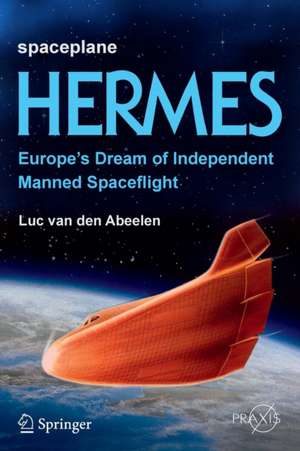Spaceplane HERMES: Europe's Dream of Independent Manned Spaceflight: Springer Praxis Books
Autor Luc van den Abeelenen Limba Engleză Paperback – 21 dec 2016
Din seria Springer Praxis Books
-
 Preț: 294.46 lei
Preț: 294.46 lei -
 Preț: 223.45 lei
Preț: 223.45 lei -
 Preț: 193.12 lei
Preț: 193.12 lei -
 Preț: 167.85 lei
Preț: 167.85 lei -
 Preț: 288.98 lei
Preț: 288.98 lei -
 Preț: 323.74 lei
Preț: 323.74 lei -
 Preț: 401.38 lei
Preț: 401.38 lei -
 Preț: 264.12 lei
Preț: 264.12 lei - 8%
 Preț: 513.00 lei
Preț: 513.00 lei -
 Preț: 190.01 lei
Preț: 190.01 lei -
 Preț: 218.16 lei
Preț: 218.16 lei -
 Preț: 312.06 lei
Preț: 312.06 lei - 17%
 Preț: 414.05 lei
Preț: 414.05 lei -
 Preț: 216.41 lei
Preț: 216.41 lei -
 Preț: 262.27 lei
Preț: 262.27 lei -
 Preț: 264.35 lei
Preț: 264.35 lei -
 Preț: 167.63 lei
Preț: 167.63 lei -
 Preț: 284.81 lei
Preț: 284.81 lei -
 Preț: 259.08 lei
Preț: 259.08 lei -
 Preț: 305.47 lei
Preț: 305.47 lei -
 Preț: 244.14 lei
Preț: 244.14 lei -
 Preț: 227.85 lei
Preț: 227.85 lei -
 Preț: 285.25 lei
Preț: 285.25 lei -
 Preț: 295.56 lei
Preț: 295.56 lei -
 Preț: 357.17 lei
Preț: 357.17 lei -
 Preț: 275.79 lei
Preț: 275.79 lei -
 Preț: 257.08 lei
Preț: 257.08 lei -
 Preț: 349.71 lei
Preț: 349.71 lei -
 Preț: 272.45 lei
Preț: 272.45 lei -
 Preț: 270.27 lei
Preț: 270.27 lei - 8%
 Preț: 456.51 lei
Preț: 456.51 lei -
 Preț: 352.34 lei
Preț: 352.34 lei - 8%
 Preț: 394.80 lei
Preț: 394.80 lei -
 Preț: 320.65 lei
Preț: 320.65 lei -
 Preț: 325.29 lei
Preț: 325.29 lei -
 Preț: 253.11 lei
Preț: 253.11 lei -
 Preț: 192.86 lei
Preț: 192.86 lei -
 Preț: 313.40 lei
Preț: 313.40 lei -
 Preț: 150.51 lei
Preț: 150.51 lei -
 Preț: 233.34 lei
Preț: 233.34 lei -
 Preț: 286.78 lei
Preț: 286.78 lei -
 Preț: 212.01 lei
Preț: 212.01 lei -
 Preț: 366.83 lei
Preț: 366.83 lei -
 Preț: 299.99 lei
Preț: 299.99 lei -
 Preț: 232.27 lei
Preț: 232.27 lei -
 Preț: 284.58 lei
Preț: 284.58 lei -
 Preț: 212.45 lei
Preț: 212.45 lei -
 Preț: 159.81 lei
Preț: 159.81 lei -
 Preț: 349.48 lei
Preț: 349.48 lei - 20%
 Preț: 2061.64 lei
Preț: 2061.64 lei
Preț: 375.01 lei
Nou
Puncte Express: 563
Preț estimativ în valută:
71.77€ • 74.65$ • 59.25£
71.77€ • 74.65$ • 59.25£
Carte disponibilă
Livrare economică 24 martie-07 aprilie
Preluare comenzi: 021 569.72.76
Specificații
ISBN-13: 9783319444703
ISBN-10: 3319444700
Pagini: 704
Ilustrații: XXII, 588 p. 187 illus., 97 illus. in color.
Dimensiuni: 155 x 235 x 43 mm
Greutate: 0.84 kg
Ediția:1st ed. 2017
Editura: Springer International Publishing
Colecția Springer
Seriile Springer Praxis Books, Space Exploration
Locul publicării:Cham, Switzerland
ISBN-10: 3319444700
Pagini: 704
Ilustrații: XXII, 588 p. 187 illus., 97 illus. in color.
Dimensiuni: 155 x 235 x 43 mm
Greutate: 0.84 kg
Ediția:1st ed. 2017
Editura: Springer International Publishing
Colecția Springer
Seriile Springer Praxis Books, Space Exploration
Locul publicării:Cham, Switzerland
Cuprins
Origins: re-entry vehicles and orbital factories.- Getting serious: CNES develops a concept.- One or the other: selecting the prime contractor.- Safety rethink: the Challenger accident.- The road not taken: CNES decides against Maia.- The Hague: adoption by ESA.- Ever growing: Hermes gains a module.- Competition and the others: spacecraft from around the world.- Shifting priorities: equipment relocations (1989-1990).- The transatlantic scene: Freedom struggles, Columbus and the DoD.- Buying time: the six-month extension of Phase 1 (1990).- Outside influence: the costly fall of the Berlin Wall (1990-1991).- Change at Munich: stretching the imagination (1991).- Scaling down: X-2000 and Russia to the rescue (1991-1992).- Grenada: the end of the road (1992).- Descendants: of astronauts and wings.- Space freighter for ISS: the promise of ATV.- Hermes’ legacy: a continued mission of sorts.- Keeping in touch: the DRS satellites and Mission Control.- Staying cool: the thermal protection system.- In Orbit Infrastructure: Platforms and Space Stations.- Learning to fly: astronauts and their training.- Inside and out: the space suits and escape systems.- Lift-off and getting home safely: preparation, launch and landing facilities.- Looking back: the Hermes experience.- Afterword.- Appendix A.- Appendix B.- Appendix C.
Recenzii
“Spaceplane HERMES is a very thorough book on the long history of the European quest to develop an independent human spaceflight capability. … this reviewer views this book as an example of what works and what does not and how politics, diplomacy, funding, and technical challenges play into the development of complex international space systems. Overall, this book is appropriate for any individual with an interest in space history. Summing Up: Recommended. Lower- and upper-division undergraduates; professionals and general readers.” (D. B. Spencer, Choice, Vol. 57 (11), July, 2017)
“A great book! A necessary book! … For me the book in its chronological order and panoramic picture of all the managerial, technological, and political aspects of the Hermes project lets me fill in many gaps and leads to a better understanding of decisions which were not clear at all at the time. … the book demonstrates the dream is alive and hopefully the next generation of politicians, managers and engineers will be educated by this ‘historical’ book.” (Joachim J. Kehr, Journal of Space Operations & Communicator, opsjournal.org, Vol. 4 (1), January, 2017)“The book is written with an easy fl owing style which makes it suitable for all readerships. … Arranged in chronological order, it opens in 1946 with France’s fi rst tentative dreams of space. It is an attractively presented publication, well illustrated with diagrams and pictures. One must also not forget the extensive index.” (Odyssey: The e-Magazine of the British Interplanetary Society, Issue 51, January, 2017)
Notă biografică
Luc van den Abeelen’s first publication was in Spaceflight magazine in 1987 on the subject of the Mir space station. He continued the Soviet/Russian theme of his writing and in 1999, wrote on the historical theme of the Soviet Lunar landing program, and, in the same year, in JBIS on the history of later planned Soviet Lunar mission. For the past 15 years, he has contributed commentary on current space events on national Dutch radio and television.
Textul de pe ultima copertă
This is the first comprehensive book on the European Hermes program. It tells the fascinating story of how Europe aimed for an independent manned spaceflight capability which was to complement US and Soviet/Russian space activities.In 1975, France decided to expand its plans for automated satellites for materials processing to include the development of a small 10 ton spaceplane to be launched on top of a future heavy-lifting Ariane rocket. This Hermes spaceplane would give Europe its own human spaceflight capability for shuttling crews between Earth and space stations. The European Space Agency backed the proposal. Unfortunately, after detailed studies, the project was cancelled in 1993. If Hermes had been introduced into service, it could have become the preferred "space taxi" for ferrying crews to and from the International Space Station. But that opportunity was lost. This book provides the first look of the complete story of and reasons for the demise of thisambitious program. It also gives an account which pieces of Hermes survived and are active in the 2nd decade of the 21st century. This fascinating story will be a great read for space enthusiasts. But it will also serve as a comprehensive documentation of an important episode in the history of manned spaceflight.
Caracteristici
Presents the first comprehensive book on Hermes: technology and history of the European spaceplane program Provides the complete story of Hermes and the reasons for the demise of this ambitious space technology program Carefully investigated by studying the original archives and supported by interviews with the key people involved in the program Provides a detailed description of the evolution of the design to accommodate changing requirements Gives an account of which pieces of technolgy developed for Hermes do survive today, in the 2nd decade of the 21st century, like in ARIANE 5 or ESA's IXV re-entry test vehicle




